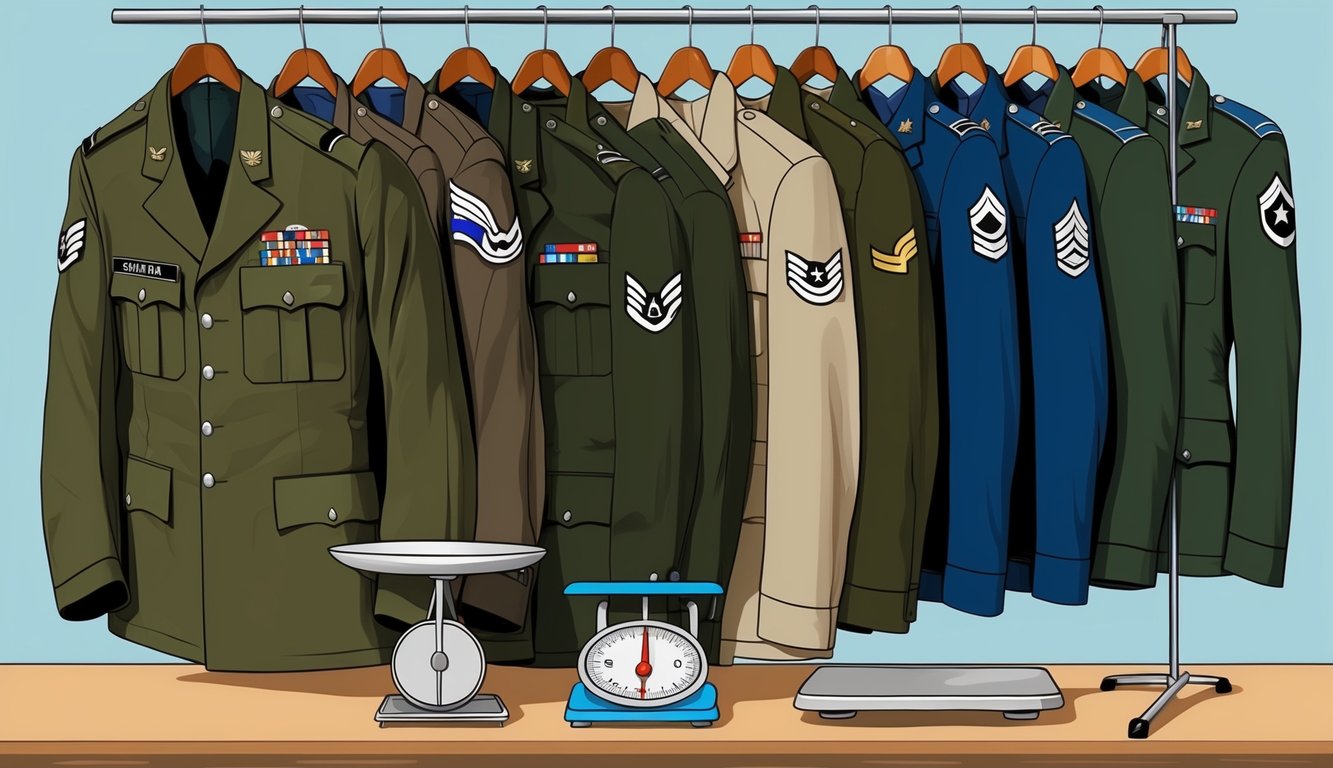Joining the Army represents more than just a job; it signifies a dedication to achieving both physical and mental excellence.
The U.S. Army enforces stringent height and weight criteria to guarantee that soldiers are fit for their responsibilities and can perform their duties effectively. These criteria differ based on factors such as age, gender, and height, and include specific requirements regarding body fat percentage and overall fitness.
If you’re contemplating enlisting or want to learn how the Army assesses physical readiness, understand that it’s more comprehensive than simply stepping onto a scale.
Soldiers regularly undergo body composition evaluations, which include tape measurements and BMI calculations.
These assessments are vital for ensuring a combat-ready and resilient force.
Adhering to Army height and weight standards isn’t solely about looking sharp in uniform; it’s about being equipped for the physical challenges of military service.
Your fitness level can significantly influence mission success and personal safety, whether you are scaling walls, transporting heavy gear, or participating in extended marches.
Key Takeaways
- Army height and weight standards are tailored by age, gender, and height to confirm soldiers’ readiness for combat.
- Regular body composition evaluations consist of tape measurements and BMI calculations.
- Meeting these standards is essential for mission accomplishment and personal safety in military endeavors.
Understanding the Army’s Physical Requirements
The U.S. Army enforces precise physical standards to ensure that soldiers can meet the demands of military service.
These criteria encompass height, weight, and overall fitness levels essential for maintaining combat readiness.
The Importance of Physical Fitness in the Army
Physical fitness is crucial for soldiers to effectively execute their responsibilities.
It is imperative to be in peak condition to withstand the challenges of training and combat scenarios.
The Army’s fitness standards ensure that you can manage heavy loads, respond swiftly in tactical settings, and endure prolonged periods of physical strain.
Maintaining regular exercise and proper nutrition is vital to satisfying these standards.
Soldiers are expected to engage in daily physical training to enhance strength, endurance, and agility, ultimately preparing them for the Army Physical Fitness Test, which assesses cardiovascular endurance and muscular strength.
An Overview of Height and Weight Standards
The Army has established specific height and weight standards to uphold a fit and capable force.
Height and weight are accurately measured using calibrated scales and appropriate methods.
Allowable weight ranges vary according to age, gender, and height.
For instance, if you are a male soldier aged 17-20 with a height of 68 inches, your weight must fall between 132 and 178 pounds.
Female soldiers of the same height and age group should weigh between 120 and 168 pounds.
These standards are designed to ensure you maintain a healthy body composition for optimal performance.
If you do not meet these standards, you may need to participate in the Army Body Composition Program, which includes nutritional guidance and aims for a safe weight reduction of approximately 1-2 pounds per week through calorie management and increased physical activity.
Specific Standards and Regulations
The U.S. Army has definitive height and weight standards for its soldiers.
These guidelines are designed to differ between genders and age groups, ensuring fitness across various demographics.
Height and Weight Tables for Male and Female Soldiers
Army regulations define specific height and weight requirements for both men and women.
The minimum height for men is 60 inches (5 feet) and the maximum is 80 inches (6 feet 8 inches).
Women have a slightly different height range.
Weight limits correspond to height and are specific to gender.
For example, a 5’8″ male soldier aged 17-20 is expected to weigh between 132-180 pounds, while a female soldier of the same height and age should weigh between 117-155 pounds.
These tables facilitate quick verification of whether you meet the fundamental standards.
Should you exceed the maximum allowable weight for your height, a body fat assessment may be required.
Age Group Variances in Army Standards
As soldiers age, the Army adjusts its weight standards to reflect natural bodily changes.
Older service members are permitted slightly higher weight limits compared to their younger counterparts.
For example, a 30-year-old male soldier standing at 70 inches can weigh up to 190 pounds, while the same height for a 40-year-old male allows for up to 196 pounds.
Similar allowances apply to female soldiers.
Body fat percentage criteria also differ with age.
Younger soldiers (17-20) face stricter limits, while those over 40 can tolerate a higher body fat percentage.
This tiered approach acknowledges the physical changes that accompany aging while sustaining overall fitness standards.
Body Composition Assessment

The Army employs specific techniques to assess soldiers’ body composition and ensure they meet fitness standards.
These evaluations are essential for maintaining combat readiness and promoting overall health.
Understanding Body Fat Standards
Body fat standards are determined by age and gender within the Army.
For men aged 17-20, the maximum allowable body fat percentage is 20%.
This figure increases to 22% for ages 21-27, 24% for 28-39, and 26% for those aged 40 and above.
Women’s limits are slightly more lenient at 30% for ages 17-20, 32% for 21-27, 34% for 28-39, and 36% for those over 40.
It’s crucial to stay within these limits to meet Army expectations.
Regular assessments enable you to monitor your progress and adjust your diet and exercise accordingly.
The Tape Test Methodology
The Army primarily utilizes the circumference-based tape method for body fat assessment.
This method involves measuring the neck and abdomen (for men) or neck, waist, and hips (for women).
The resulting measurements are incorporated into a formula to estimate body fat percentage.
To conduct the tape test:
- Stand straight with your arms at your sides.
- Measure each site three times.
- Calculate the average to the nearest 1/4 inch.
This test is quick and easy to administer, although not always the most precise.
For greater precision, some units utilize the Bod Pod® Body Composition Tracking System, which calculates body density using air displacement.
Army Fitness Testing
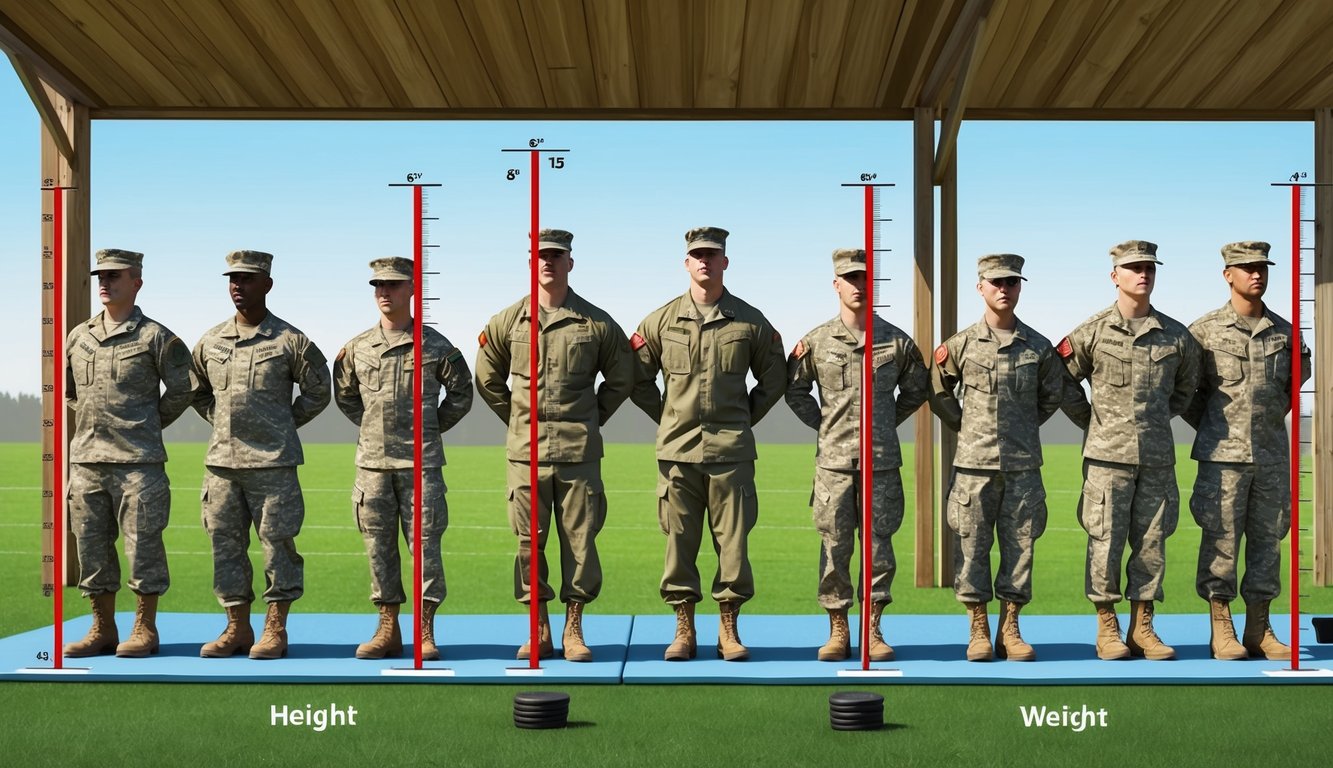
The Army evaluates soldiers’ physical readiness through comprehensive fitness tests.
These evaluations assess strength, endurance, and overall combat readiness.
Components of the Army Combat Fitness Test
The Army Combat Fitness Test (ACFT) has replaced the previous Army Physical Fitness Test and consists of six events that simulate battlefield tasks:
- Three-repetition maximum deadlift
- Standing power throw
- Hand-release push-ups
- Sprint-drag-carry
- Leg tuck or plank
- Two-mile run
Preparation for each component is essential to meeting standards.
The deadlift measures lower body strength, while the power throw tests explosiveness.
Hand-release push-ups gauge upper body endurance.
The sprint-drag-carry event mimics combat movements.
You can opt for leg tucks or planks to challenge your core strength.
Lastly, the two-mile run assesses your cardiovascular fitness.
Alternate Events and Adaptations
The Army offers alternative events for soldiers with permanent profiles or limitations.
These substitutions ensure that all service members can demonstrate their fitness:
- 5,000-meter row
- 12,000-meter stationary bike
- 1,000-meter swim
These alternatives may apply if a medical condition restricts participation in standard events.
The Army also accommodates pregnant and postpartum soldiers.
Grading standards vary by age and gender, with each event contributing to your overall ACFT score.
Meeting these standards is vital for career advancement and deployment readiness.
Weight Control Programs
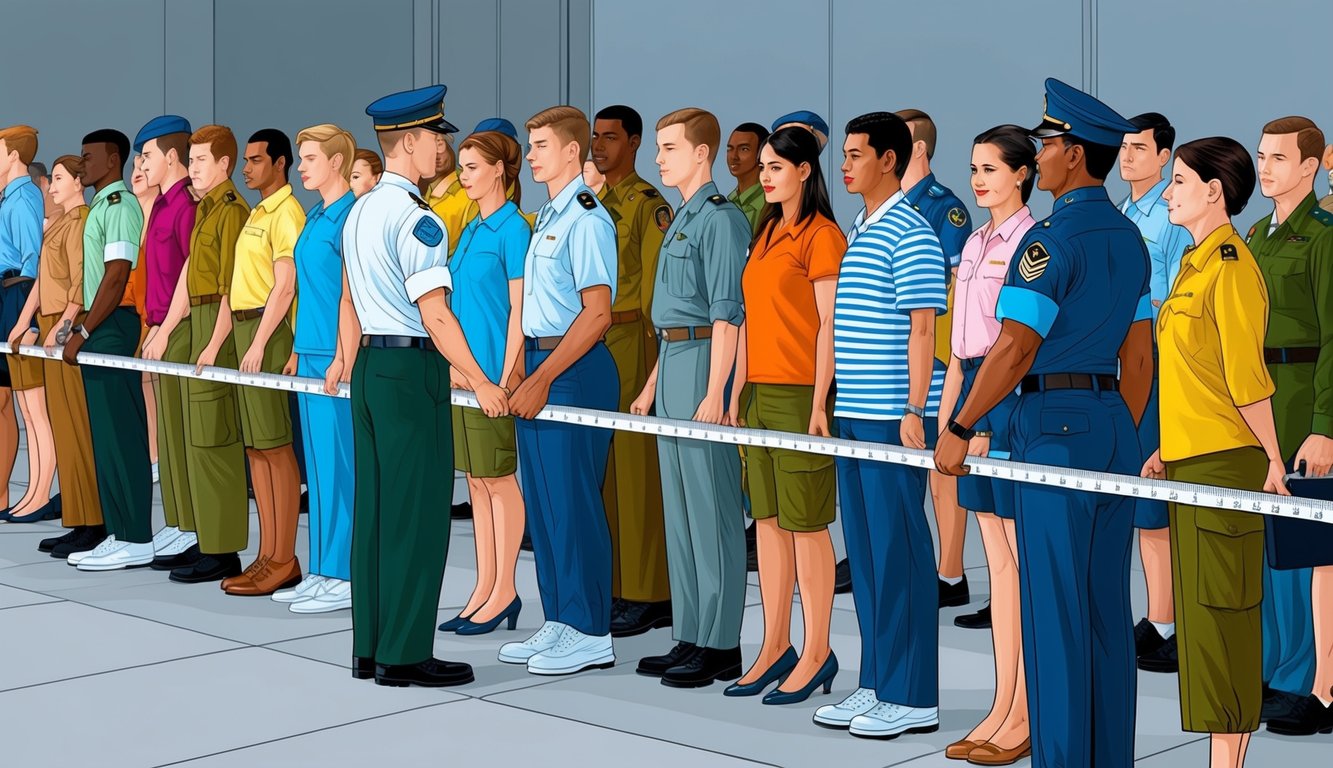
The U.S. Army has developed programs aimed at assisting soldiers in maintaining a healthy weight and body composition.
These initiatives support combat readiness while ensuring compliance with established standards.
Army Weight Control Program (AWCP)
The AWCP is designed to assist soldiers in meeting and maintaining the Army’s body composition standards.
If a soldier is deemed overweight according to the height and weight screening guidelines, they will be enrolled in this program, which offers guidance on proper nutrition and exercise necessary for achieving a healthy weight.
Participants collaborate with unit leaders and healthcare professionals to formulate a personalized plan, which may involve dietary adjustments, increased physical activity, and regular weigh-ins.
The program encourages a weight loss rate of 1-2 pounds per week, viewed as a safe and sustainable target.
It’s important to note that progress is closely monitored.
Lacking improvement could negatively affect one’s career, potentially leading to administrative measures.
Supplemental Body Fat Assessment
If a soldier exceeds the weight limit for their height, they will undergo a supplemental body fat assessment.
This evaluation includes taking specific measurements to calculate body fat percentage.
For men, neck and waist circumferences are measured, whereas women are assessed at the neck, waist, and hips.
These figures are used in a body fat calculator to determine the percentage.
The maximum permitted body fat varies by age and gender.
For example, males aged 17-20 have a limit of 20% body fat, while females in the same age bracket are allowed up to 30%.
If a soldier falls within the acceptable body fat range, they will be considered to have met the standards even if they surpass the weight limit.
Holistic Health and Fitness

The U.S. Army has embraced a comprehensive holistic approach for soldier wellness.
This framework integrates physical fitness with mental and nutritional health, aiming to enhance overall readiness and performance.
Army Directive 2023-11 and Its Implications
Army Directive 2023-11 represents a significant transition in how the military approaches fitness.
This directive emphasizes a holistic health and fitness paradigm, extending beyond mere physical strength and endurance.
The new standards prioritize your overall well-being—encompassing mental health, sleep quality, and dietary habits.
The directive’s objective is to foster more resilient and capable soldiers.
Under these revised guidelines, service members are encouraged to adopt sustainable health practices.
This method aims to reduce injuries and enhance long-term health outcomes for personnel.
Incorporating Sleep, Nutrition, and Activity in Fitness Regimens
Your fitness regimen now encompasses more than gym workouts.
Adequate sleep is recognized as vital for recovery and cognitive performance, with a recommendation of 7-9 hours per night.
Nutrition significantly influences your performance.
The Army now provides enhanced guidance on balanced diets, tailored to your activity levels and objectives.
Everyday activities are now seen as opportunities for fitness.
This could involve choosing stairs over elevators or integrating short walks into your daily routine.
The Army encourages tracking your progress with wearable technology.
These tools help you monitor sleep patterns, meal intake, and levels of physical activity.
By concentrating on these aspects, you are likely to see improvements in your overall health, fitness, and readiness for duty.
Entry and Assessment Processes
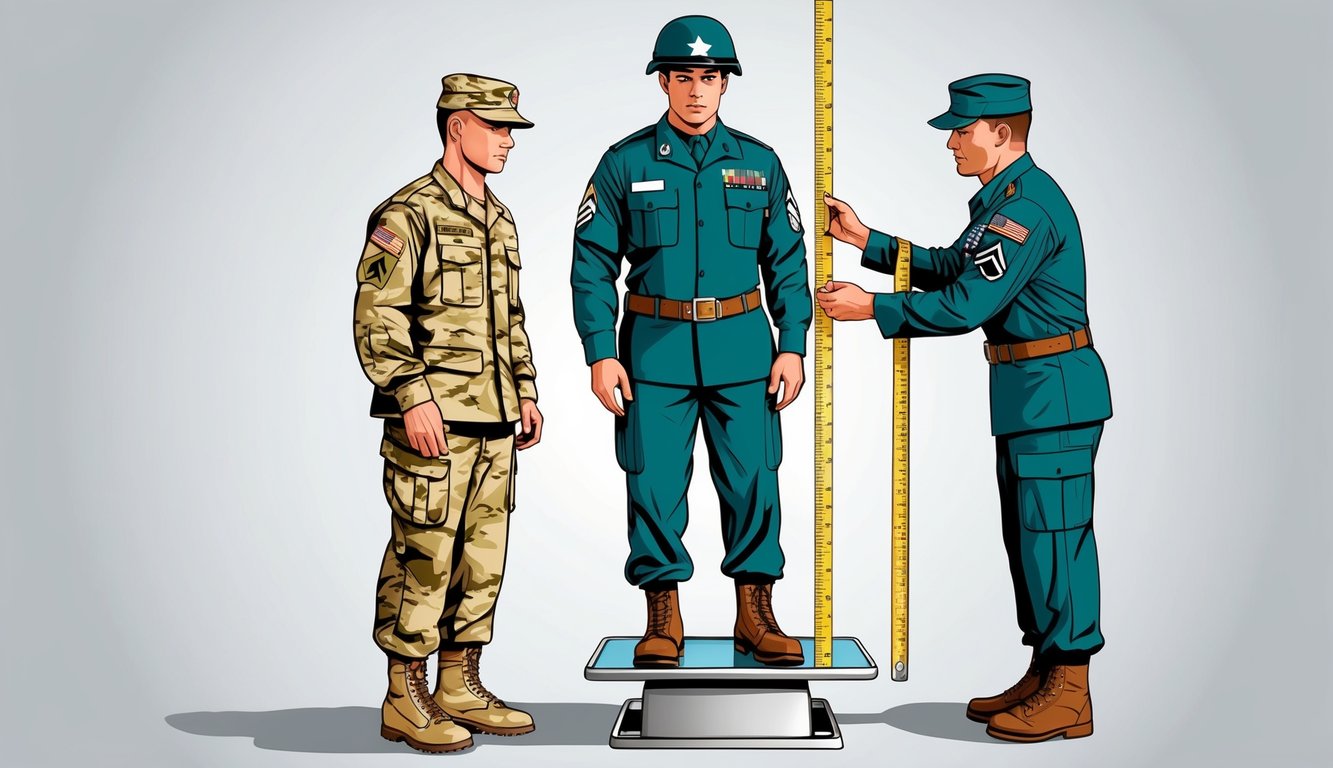
The Army uses specific procedures for evaluating the height and weight of recruits during the entry process.
You will encounter these assessments at MEPS and may receive counsel as necessary.
MEPS Physical Evaluation Procedures
At the Military Entrance Processing Station (MEPS), an extensive physical evaluation will occur.
This includes accurate height and weight measurements recorded by a medical professional, who will compare your stats against Army standards.
If your weight falls beyond the acceptable range for your height, additional screenings may be required, often involving the Army Body Fat Circumference-Based Tape Test.
This approach estimates body fat percentage when BMI alone doesn’t provide a complete picture.
This tape test measures specific body areas: men at the neck and waist, and women at the neck, waist, and hips.
These measurements are essential for determining compliance with body composition requirements.
The Role of Counseling for Weight Standards
If you are unable to meet initial weight standards, there’s no need for concern.
You will likely receive counseling aimed at helping you reach these benchmarks.
This advice is intended to support your success, not to discourage you.
A recruiter or military counselor will thoroughly outline the standards, providing recommendations on nutrition and exercise to help you achieve your goals.
A personalized plan may be established for you.
The Army is invested in your success, offering resources and support to aid you in fulfilling the requirements.
Counseling sessions are an opportunity to ask questions and receive expert guidance on improving your fitness.
You may also be allotted time to enhance your fitness before retesting, allowing you to implement positive dietary and exercise changes.
Training for Success
To meet and uphold Army height and weight standards, dedication and consistent effort are essential.
Proper preparation and strategic planning can dramatically enhance your likelihood of satisfying these requirements.
Preparing for Basic Training
Embark on your fitness journey well before your enlistment.
Prioritize cardiovascular exercise such as running, swimming, and cycling for building endurance.
Incorporate strength training to develop muscle and elevate metabolism.
Focus on a nutritious diet—incorporate lean proteins, complex carbohydrates, and ample fruits and vegetables.
Utilize the Army’s height and weight calculator to establish your target weight.
If you find yourself overweight, create a caloric deficit through your diet and exercise.
Conversely, if you are underweight, increase caloric intake with nutrient-rich foods and integrate resistance training.
Ensure you get adequate sleep and manage stress, as these factors affect weight and your overall fitness.
Consider joining a local fitness group or teaming up with a workout partner to enhance motivation and accountability.
Strategies for Meeting and Maintaining Standards
Once you join the Army, it becomes critical to consistently meet established standards.
Cultivate a regular workout regimen that encompasses both cardio and strength training.
Aim for at least 150 minutes of moderate-intensity exercise weekly.
Monitor portion sizes and opt for nutritious choices within the dining facility.
Favor grilled items over fried ones, select whole grains, and load up on vegetables.
Maintain hydration by drinking water throughout the day.
Conduct regular self-assessments using a tape measure to stay on course.
If you find yourself struggling, seek assistance from your unit’s Master Fitness Trainer or a nutrition specialist.
They can offer tailored guidance and encouragement.
Keep in mind that fitness is a lifestyle.
Integrate healthy choices into your daily routine, both on and off duty.
By persistently working towards your fitness goals, you will be better prepared for the physical challenges of Army life and more likely to maintain required standards.
Advancement and Professional Development
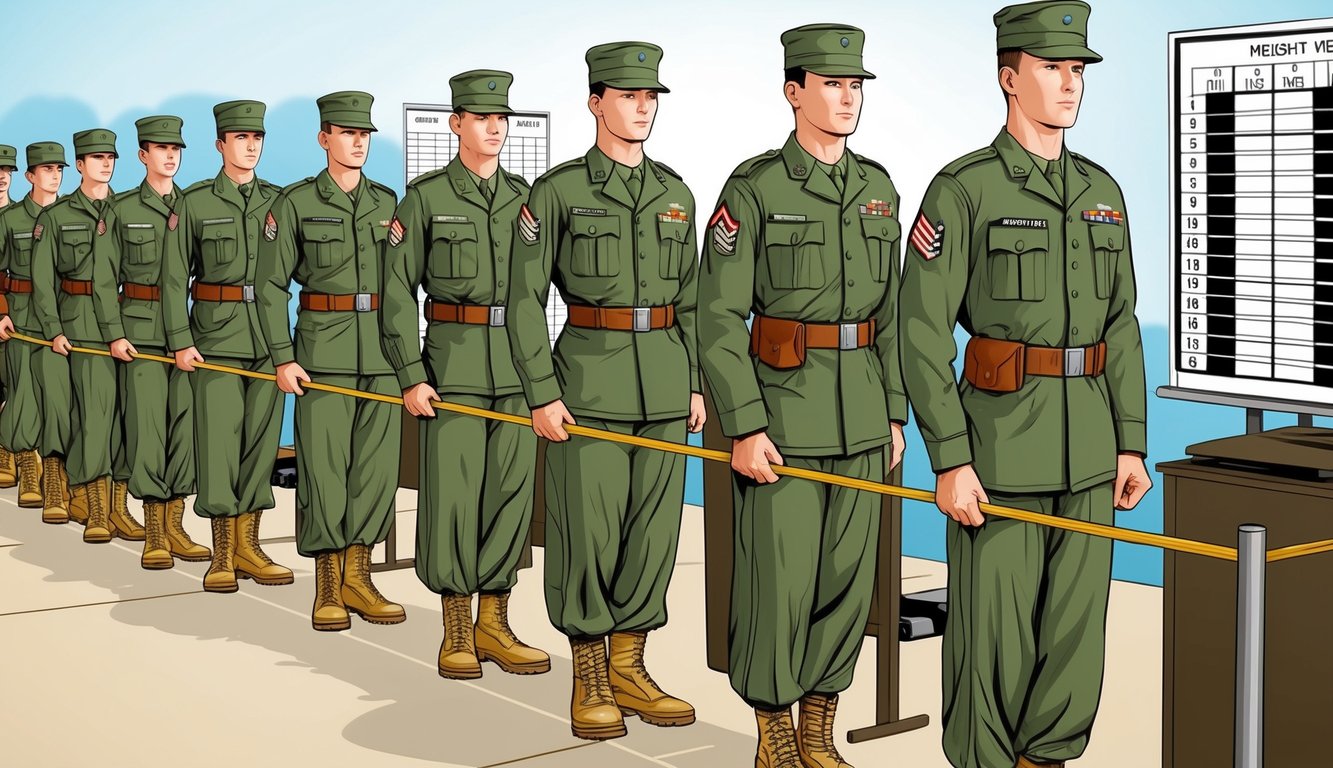
Achieving physical standards is vital for career progress within the Army.
Your ability to sustain fitness and appropriate body composition has a direct impact on opportunities for promotion and professional growth.
Career Progression and Physical Standards
To advance in your military career, it is imperative to consistently meet Army height and weight standards.
Failing to do so may restrict your chances for promotion and special assignments.
Regular fitness evaluations form part of your performance assessment.
Exceeding standards can distinguish you from your peers and pave the way for leadership opportunities.
Soldiers who find weight management challenging may face administrative actions, including potential discharge from service.
Conversely, maintaining outstanding physical readiness can lead to accolades and recognition, enhancing your promotion prospects.
Physical Requirements for Commissioned Officers and Enlisted Personnel
As you rise through the ranks, physical standards retain their significance for both commissioned officers and enlisted personnel.
Officers are expected to exemplify high fitness levels throughout their careers.
Enlisted soldiers must fulfill specific weight and body fat criteria based upon their age and gender.
To attend Professional Military Education courses, you must pass the Army Physical Fitness Test (APFT) and meet body composition demands.
If you fail to maintain standards during such courses, you may be removed and returned to your unit.
Physical Training and Performance Enhancement
Physical training is crucial in meeting Army height and weight standards, enabling soldiers to develop strength, endurance, and maintain an ideal body composition.
Developing Strength and Aerobic Endurance
To thrive in Army fitness tests, prioritize building strength alongside aerobic endurance.
Include compound exercises such as squats, deadlifts, and bench presses in your regimen.
These movements engage various muscle groups for comprehensive power enhancement.
For aerobic endurance, incorporate activities like running, swimming, or cycling into your routine.
Aim for 3-4 cardio sessions weekly, with each lasting 30-45 minutes.
Gradually increase the intensity and duration as your fitness improves.
Don’t compromise on core strength.
Exercises like planks, Russian twists, and leg raises will help stabilize your body and improve your posture during workouts.
The Importance of Consistency and Regular Assessments
Consistency is crucial on your path to physical training.
Establish a regular workout routine targeting 4-5 sessions weekly to cultivate habits and ensure consistent advancement.
Track your progress with regular self-assessments.
Monthly evaluations of your repetition maximum deadlift will provide insight into strength improvements.
For cardio endurance, periodically time your two-mile run to gauge improvements.
Utilizing a fitness app or journal to document workouts and progress can help identify areas needing attention and maintain motivation.
Remember, even minor consistent improvements accumulate over time.
Be prepared to adjust your training based on assessment findings.
If specific areas present challenges, allocate additional time to them during your workouts.
Frequently Asked Questions
The Army’s height and weight standards can be intricate.
Here are answers to some frequently asked questions regarding these requirements and their application.
How do I calculate my height and weight for the Army standards?
Your height should be measured in inches without shoes, while weight is taken on a calibrated scale in minimal clothing.
Compare your figures with the Army’s official height and weight charts to determine compliance.
Is there a different height and weight chart for men and women in the Army?
Yes, the Army implements distinct charts for men and women, taking into account natural bodily composition differences between genders.
Weight limits are generally lower for women at each height.
What are the body fat percentage requirements for Army enlistment?
Maximum allowable body fat percentages differ based on age and gender.
For men aged 17-20, the limit is 20%; for women, it is 30%.
These limits adjust slightly with age to reflect natural changes in the body.
Are the height and weight requirements in the Army the same for all ages?
No, height and weight standards vary by age group.
As soldiers age, the permissible weight range increases slightly to accommodate natural changes in body composition.
What is the ‘tape test’ used for in the Army?
The tape test measures body circumferences to estimate body fat percentage and is conducted when a soldier exceeds weight limits for their height.
It involves measuring the neck and waist for men, and neck, waist, and hips for women.
Can I enlist in the Army if I’m under the minimum weight?
Being underweight could disqualify you from enlisting, as the Army has minimum weight requirements to ensure that soldiers can meet the physical demands of service.
If you are near the minimum weight, it might be possible to gain weight and qualify.

